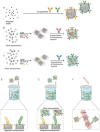Novel Biorecognition Elements against Pathogens in the Design of State-of-the-Art Diagnostics
- PMID: 34821636
- PMCID: PMC8615483
- DOI: 10.3390/bios11110418
Novel Biorecognition Elements against Pathogens in the Design of State-of-the-Art Diagnostics
Abstract
Infectious agents, especially bacteria and viruses, account for a vast number of hospitalisations and mortality worldwide. Providing effective and timely diagnostics for the multiplicity of infectious diseases is challenging. Conventional diagnostic solutions, although technologically advanced, are highly complex and often inaccessible in resource-limited settings. An alternative strategy involves convenient rapid diagnostics which can be easily administered at the point-of-care (POC) and at low cost without sacrificing reliability. Biosensors and other rapid POC diagnostic tools which require biorecognition elements to precisely identify the causative pathogen are being developed. The effectiveness of these devices is highly dependent on their biorecognition capabilities. Naturally occurring biorecognition elements include antibodies, bacteriophages and enzymes. Recently, modified molecules such as DNAzymes, peptide nucleic acids and molecules which suffer a selective screening like aptamers and peptides are gaining interest for their biorecognition capabilities and other advantages over purely natural ones, such as robustness and lower production costs. Antimicrobials with a broad-spectrum activity against pathogens, such as antibiotics, are also used in dual diagnostic and therapeutic strategies. Other successful pathogen identification strategies use chemical ligands, molecularly imprinted polymers and Clustered Regularly Interspaced Short Palindromic Repeats-associated nuclease. Herein, the latest developments regarding biorecognition elements and strategies to use them in the design of new biosensors for pathogens detection are reviewed.
Keywords: DNAzymes; antibodies; aptamers; biorecognition; biosensor; diagnosis; enzymes; pathogens; peptide nucleic acids; peptides.
Conflict of interest statement
The authors declare no conflict of interest.
Figures






Similar articles
-
Guide to Selecting a Biorecognition Element for Biosensors.Bioconjug Chem. 2018 Oct 17;29(10):3231-3239. doi: 10.1021/acs.bioconjchem.8b00592. Epub 2018 Sep 28. Bioconjug Chem. 2018. PMID: 30216055 Free PMC article. Review.
-
New biorecognition molecules in biosensors for the detection of toxins.Biosens Bioelectron. 2017 Jan 15;87:285-298. doi: 10.1016/j.bios.2016.06.083. Epub 2016 Jun 29. Biosens Bioelectron. 2017. PMID: 27568847 Review.
-
Functional Nucleic Acids for Pathogenic Bacteria Detection.Acc Chem Res. 2021 Sep 21;54(18):3540-3549. doi: 10.1021/acs.accounts.1c00355. Epub 2021 Sep 3. Acc Chem Res. 2021. PMID: 34478272
-
Aptamer-Based Point-of-Care Devices: Emerging Technologies and Integration of Computational Methods.Biosensors (Basel). 2023 May 22;13(5):569. doi: 10.3390/bios13050569. Biosensors (Basel). 2023. PMID: 37232930 Free PMC article. Review.
-
Bacteriophage-based advanced bacterial detection: Concept, mechanisms, and applications.Biosens Bioelectron. 2021 Apr 1;177:112973. doi: 10.1016/j.bios.2021.112973. Epub 2021 Jan 6. Biosens Bioelectron. 2021. PMID: 33429203 Review.
Cited by
-
Bacteriological diagnosis of osteoarticular infections caused by Kingella kingae; a narrative review.Front Pediatr. 2025 Jan 7;12:1520636. doi: 10.3389/fped.2024.1520636. eCollection 2024. Front Pediatr. 2025. PMID: 39840323 Free PMC article. Review.
-
Advancing foodborne pathogen detection: a review of traditional and innovative optical and electrochemical biosensing approaches.Mikrochim Acta. 2025 Jan 22;192(2):102. doi: 10.1007/s00604-024-06924-x. Mikrochim Acta. 2025. PMID: 39843762 Review.
-
Evaluation of Aptamer Fluorescence Microscopy in the Diagnosis of Pulmonary Tuberculosis.Microbiol Spectr. 2022 Aug 31;10(4):e0260221. doi: 10.1128/spectrum.02602-21. Epub 2022 Jun 14. Microbiol Spectr. 2022. PMID: 35699468 Free PMC article.
-
Aptamer-Based Technologies for Parasite Detection.Sensors (Basel). 2023 Jan 4;23(2):562. doi: 10.3390/s23020562. Sensors (Basel). 2023. PMID: 36679358 Free PMC article. Review.
-
Transformative biomedical devices to overcome biomatrix effects.Biosens Bioelectron. 2025 Jul 1;279:117373. doi: 10.1016/j.bios.2025.117373. Epub 2025 Mar 12. Biosens Bioelectron. 2025. PMID: 40120290 Review.
References
-
- World Health Organization The Top 10 Causes of Death. [(accessed on 16 March 2021)]. Available online: http://www.who.int/en/news-room/fact-sheets/detail/the-top-10-causes-of-....
-
- World Health Organisation New Report Calls for Urgent Action to Avert Antimicrobial Resistance Crisis. [(accessed on 16 March 2021)]. Available online: https://www.who.int/news/item/29-04-2019-new-report-calls-for-urgent-act....
Publication types
MeSH terms
Grants and funding
LinkOut - more resources
Full Text Sources
Molecular Biology Databases

